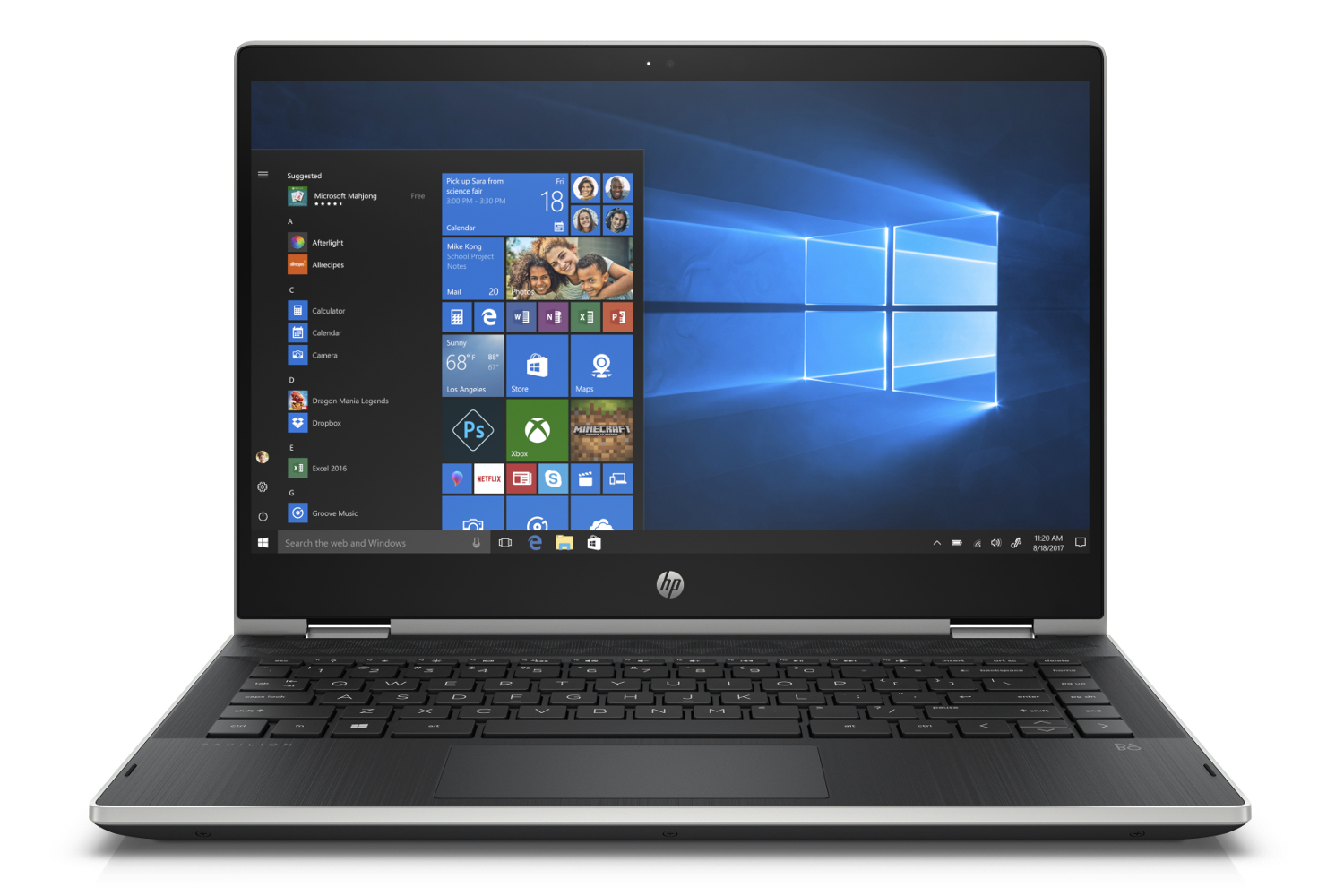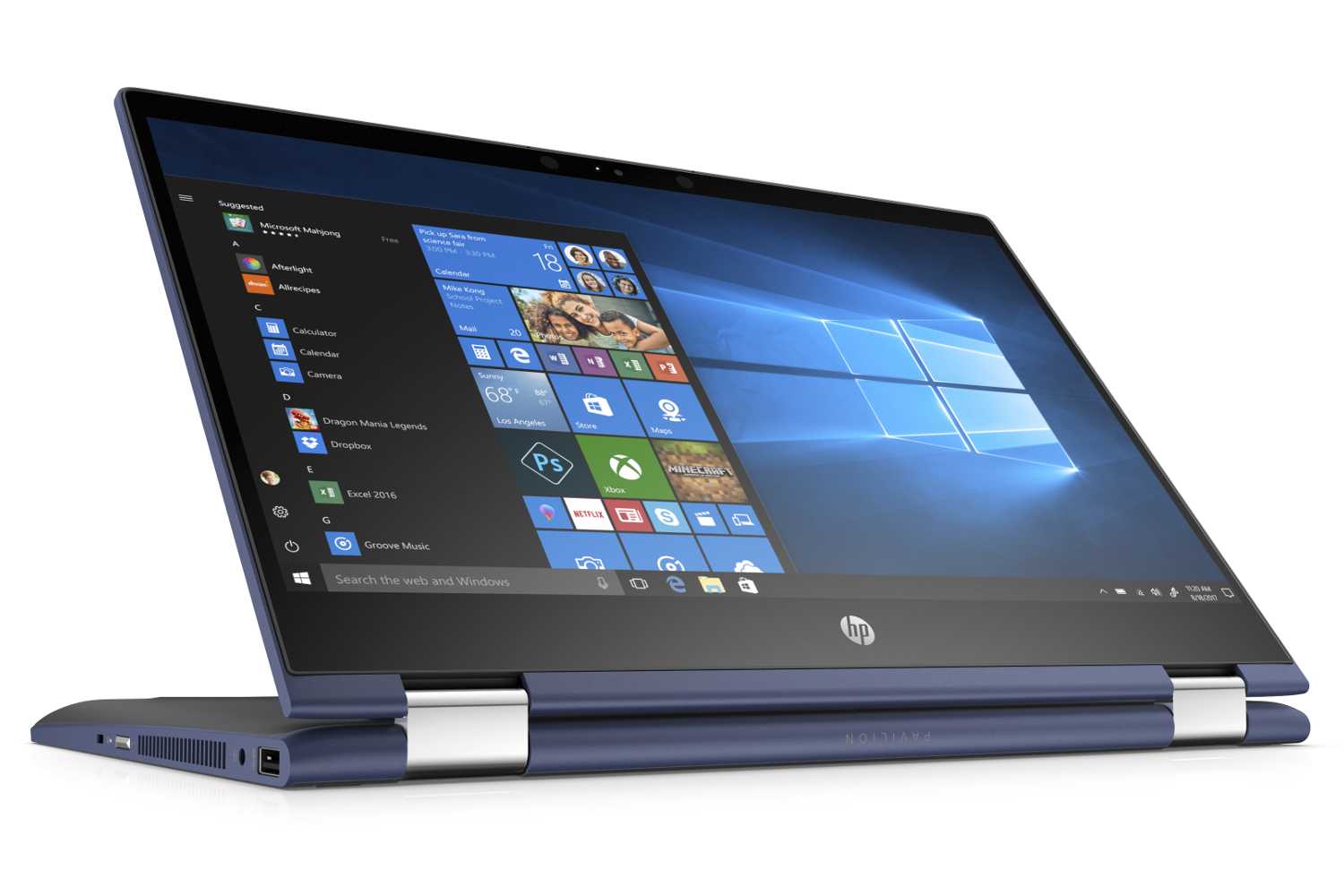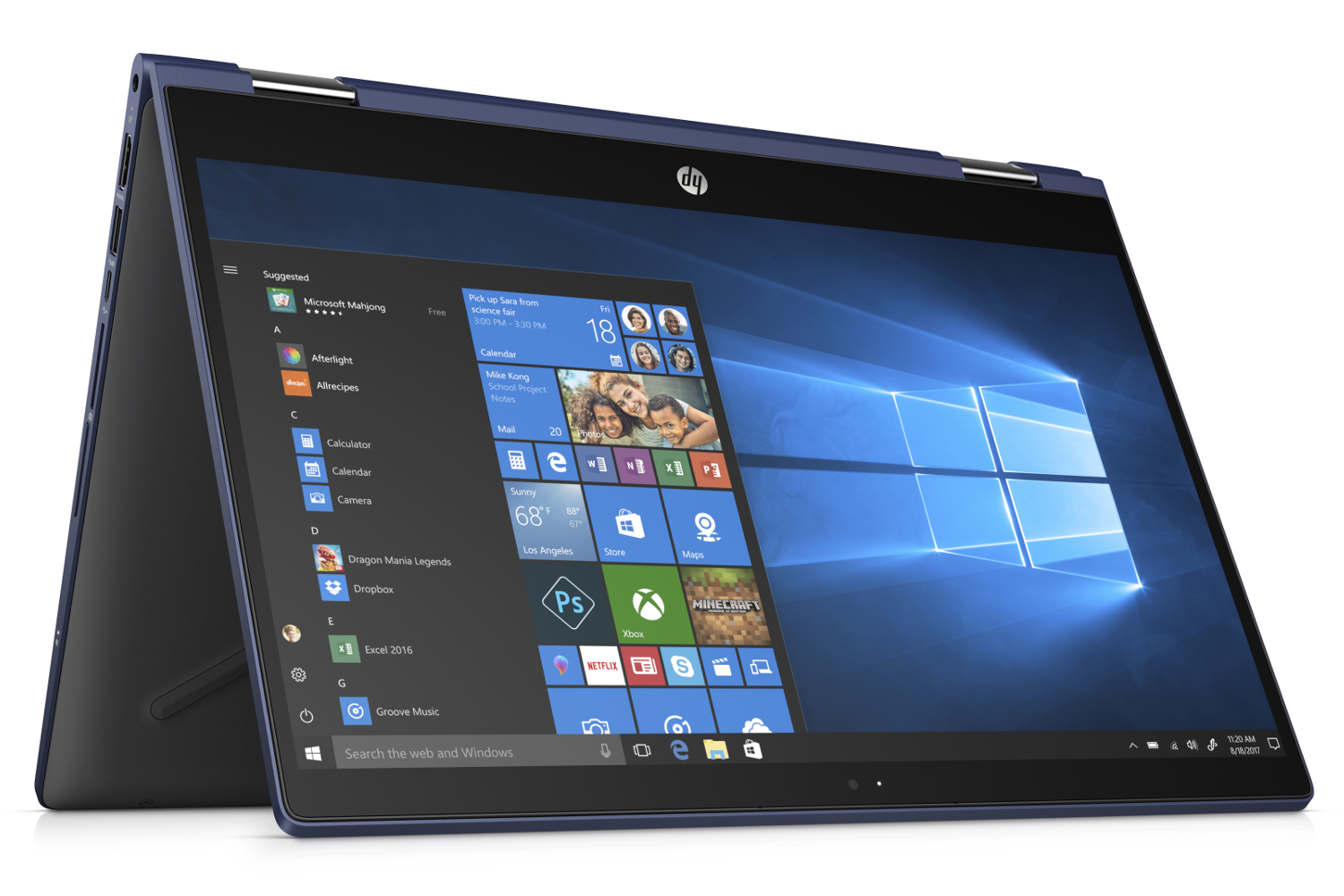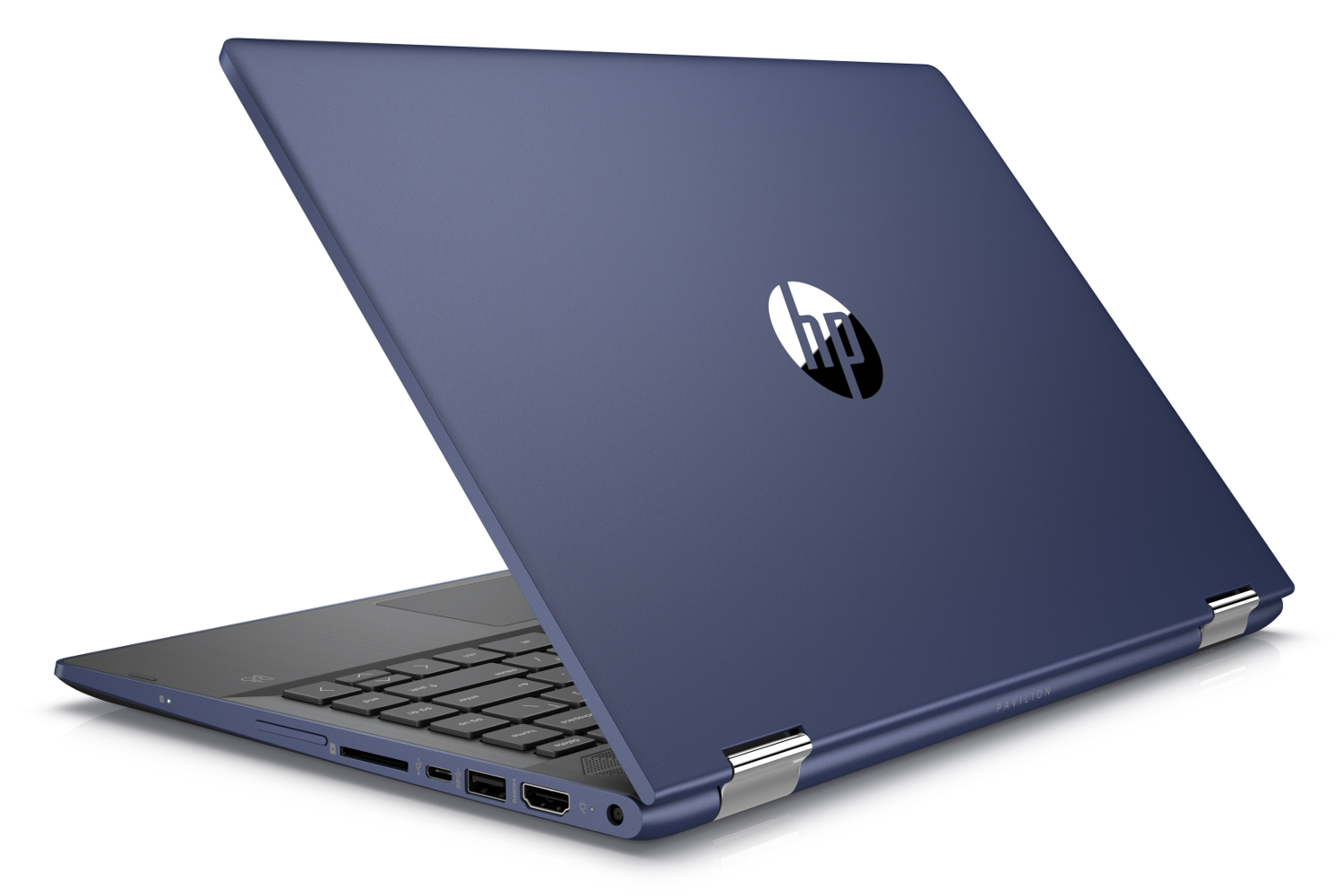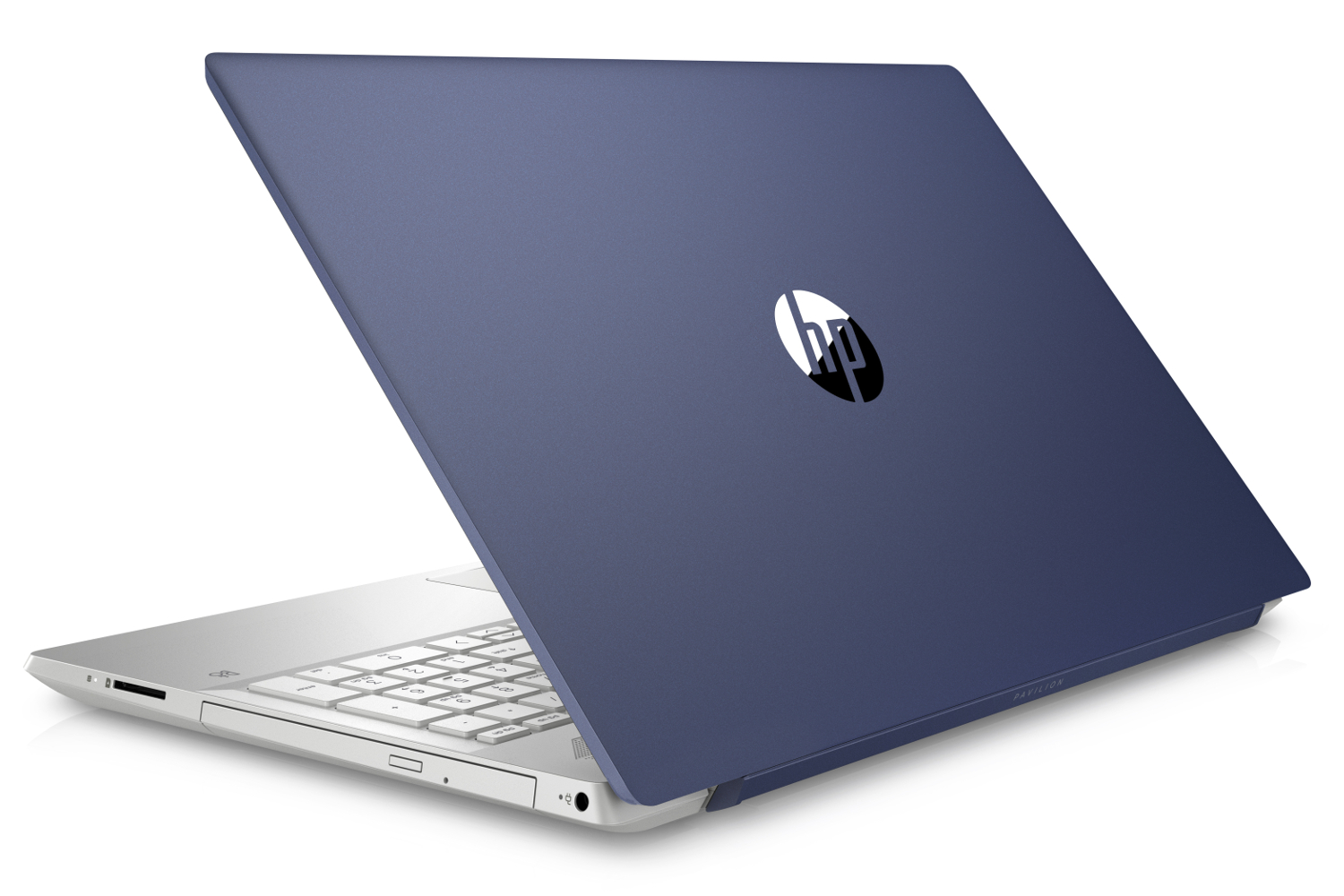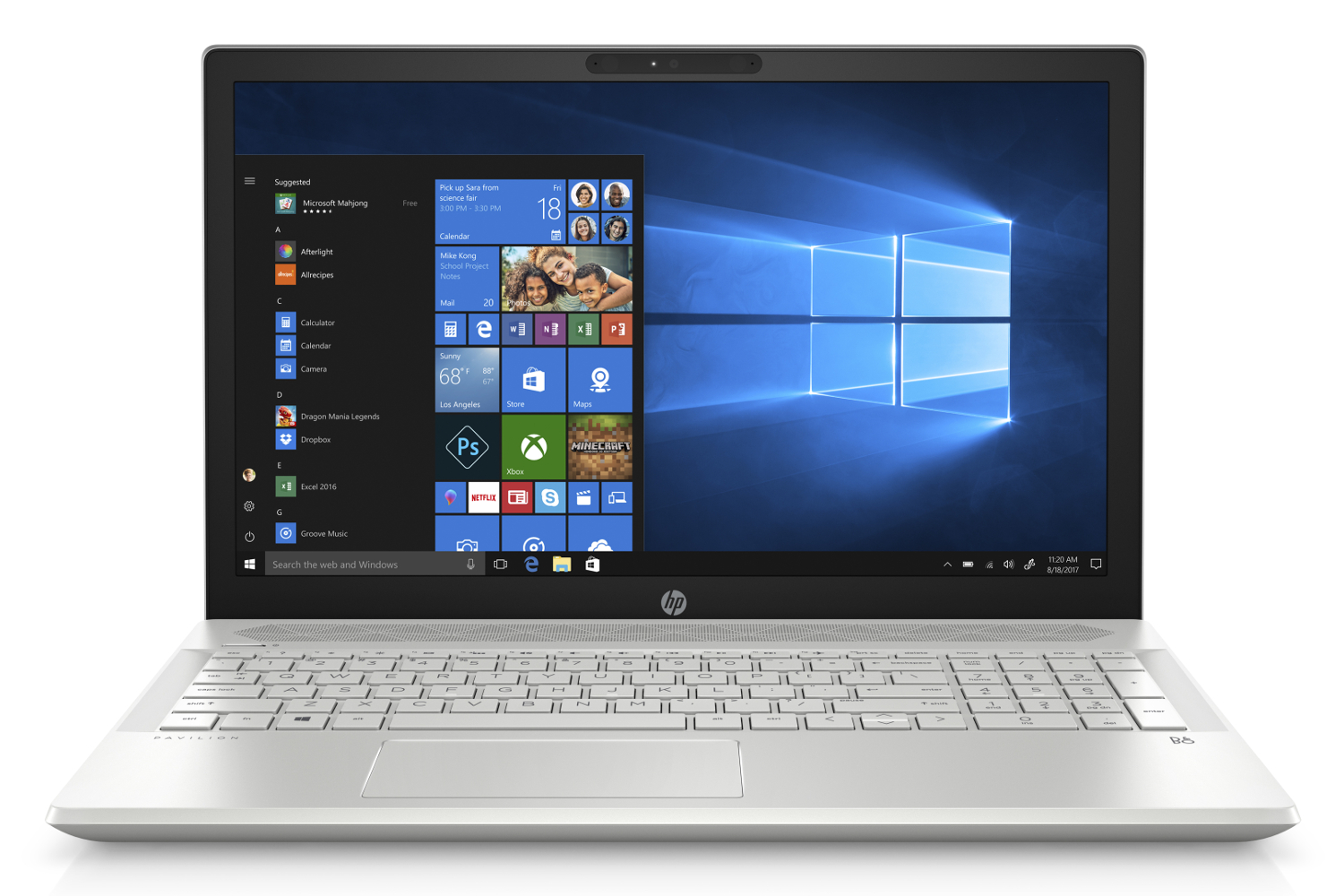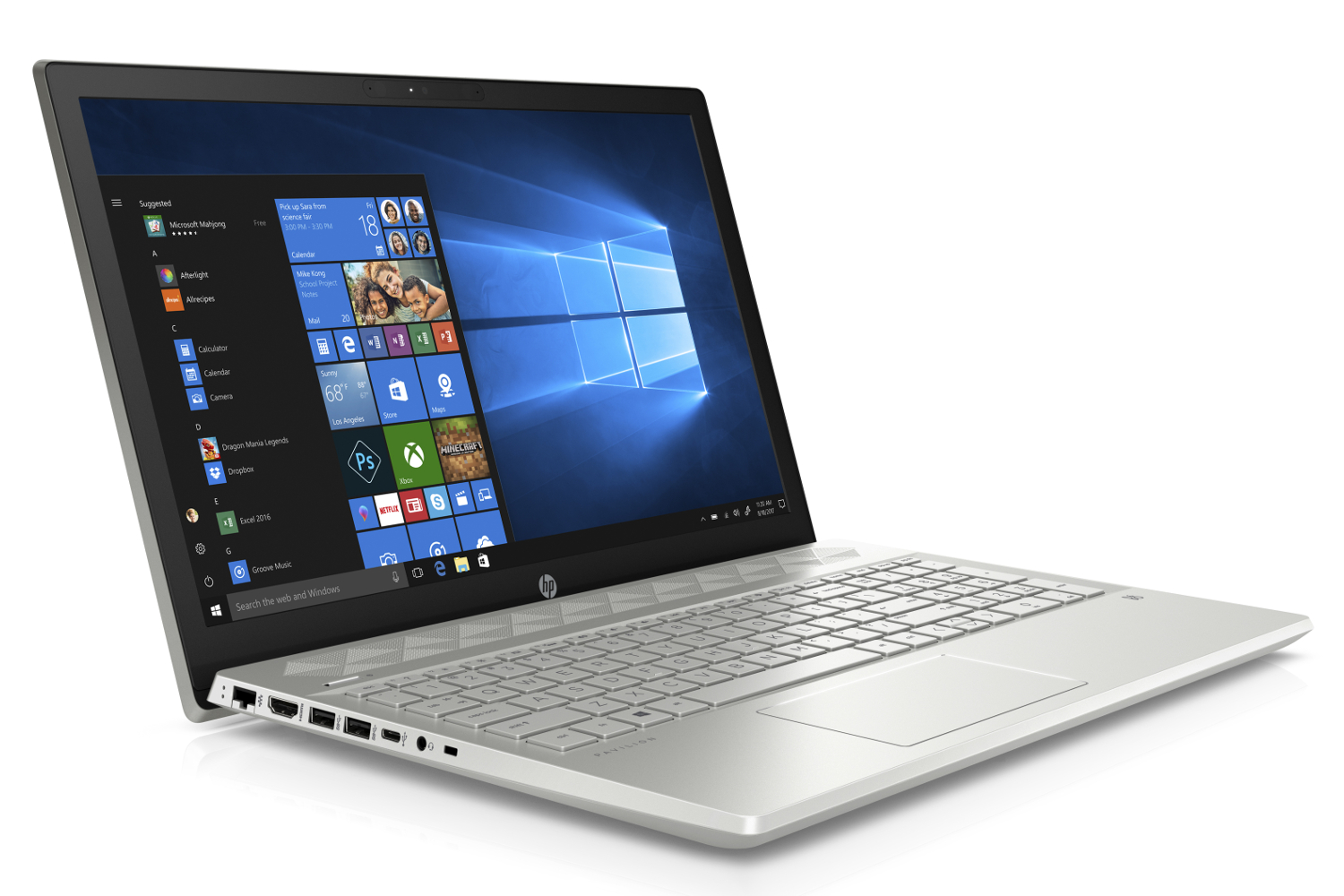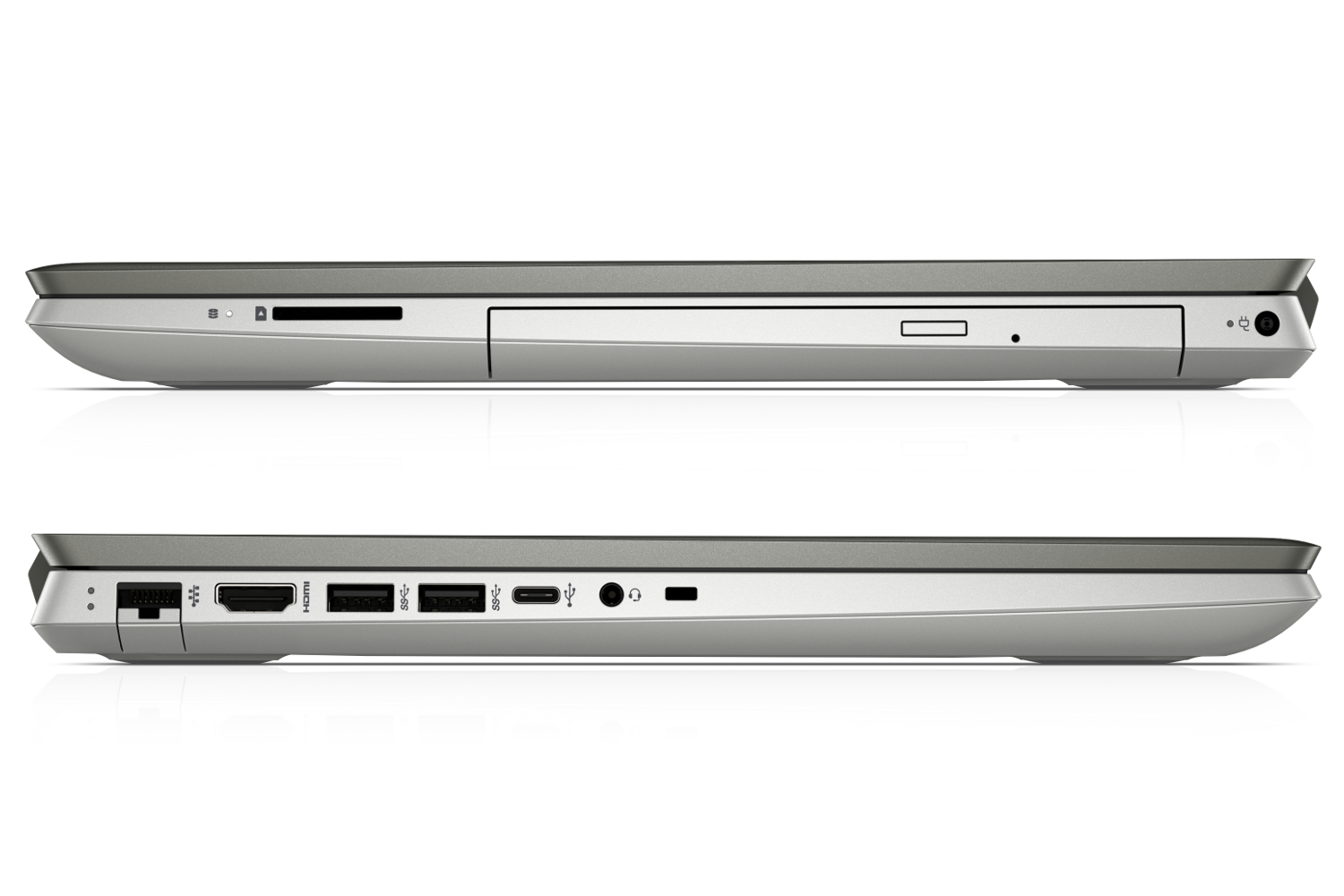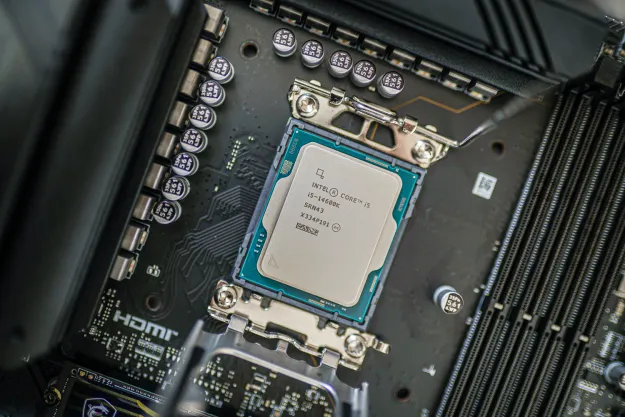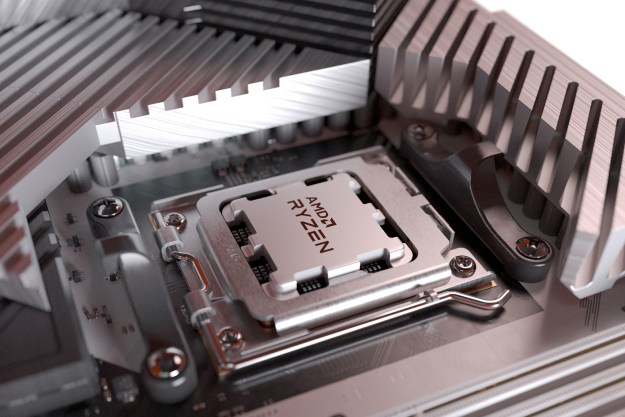In addition to revealing a new portfolio of laptops and desktops for mainstream PC gamers, HP also introduced new laptops and desktops for the non-gamers, too. In this batch we have the new Pavilion x360 2-in-1s, the traditional Pavilion Notebook in 14- and 15.6-inch variants, and revamped Pavilion desktops packing the latest processors from AMD or Intel. All models listed below will arrive in North America sometime between May and June.
First, let’s start with HP’s refreshed 2-in-1!
Pavilion x360
Key Specs
- Screen size: 14 & 15.6 inches
- Resolution: HD or FHD
- CPU: Up to Core i5-8250U
- Graphics: Integrated, discrete
- Memory: Up to 8GB (one slot)
- Storage: SDD and HDD options
- Connectivity: Wireless AC, Bluetooth
- Ports: USB-C, USB-A, HDMI
- Camera: IR or world facing
- Battery: Up to 11 hours
- Weight: Up to 4.58 pounds
- Peripheral: Pen included
- Availability: May/June
- Starting price: $499
For starters, this is HP’s 2-in-1 with a 360-hinge supporting four positions: Laptop, tent, stand, and tablet. HP said it improved the overall design to produce tighter, narrow bezels for a near-borderless screen, an edge-to-edge keyboard, and a unibody-like design in Natural Silver, Pale Gold, and Sapphire Blue colors, depending on the model. Even more, the keyboard deck has a vertical brushed pattern while the front-facing speakers mounted just above the keyboard sit under geometric speaker grills.
Customers can opt for a world-facing 5-megapixel camera with a 120-degree ultra-wide view lens that’s mounted in the top center of the speaker grill. HP also moved the fingerprint scanner to the right side of the device, parking it next to the SD card slot, USB-C port, USB-A, port, and the HDMI port (another USB-A port is on the other side). This design essentially “cleans up” the keyboard area so all you see are the keys and touchpad.
According to the specifications, models will be available with a discrete graphics chip provided by Nvidia on the 14-inch model, and a discrete GPU manufactured by AMD on the 15.6-inch model. Otherwise, you’re locked to the integrated graphics provided in the Core i5-8250U and Core i3-8130U processors. There is only one inaccessible slot for DDR4 system memory clocked at 2,400MHz, but HP says there are dual storage options mixing together hard drives and solid-state drives.
For the 14-inch model, HP installs a 41WHr battery promising up to 10 hours and 30 minutes of “mixed usage.” Meanwhile, the 15.6-inch version has a slightly larger 48WHr battery supporting up to nine hours and 15 minutes of “mixed usage.” If you’re streaming wirelessly, knock that time down to six hours and 30 minutes. Both batteries can reach 50 percent of their capacity after charging for 45 minutes.
Here are a few example configurations:
- $499 — Intel Core i3 / 8GB / 500GB HDD / HD Touch
- $729 — Intel Core i5 / 8GB / 128GB SSD / FHD IPS Touch
- $759 — Intel Core i5 / 8GB / 1TB HDD / FHD IPS Touch
Pavilion Notebook 14/15
Key Specs
- Screen size: 14 and 15.6 inches
- Resolution: HD or FHD
- CPU: AMD or Intel
- Graphics: Integrated, discrete
- Memory: Up to 8GB (one slot)
- Storage: HDD and SSD options
- Connectivity: Wireless AC, Bluetooth
- Ports: USB-C, USB-A, HDMI
- Battery: Up to 12 hours
- Weight: Up to 4.63 pounds
- Availability: May/June
- Starting price: $629
This is HP’s Pavilion-branded clamshell laptop without the cool 360-degree hinge. Again, HP refined the overall design with narrow bezels that is 10 percent thinner than the 2017 models. It also sports an enhanced lift hinge, and what HP calls an hourglass-shaped lid that is easily opened from the left, right, or front of the laptop. Its overall height is slightly shorter than the 2017 model too, measuring 0.70 inches versus last year’s 0.78-inch height. HP throws in lots of colors as well: Mineral Silver, Pale Gold, Sapphire Blue, Velvet Burgundy, Tranquil Pink, and Ceramic White.
With this model, HP is only supplying the optional fingerprint reader on the 14-inch model, located on the side like the Pavilion x360 model. Joining the scanner are a handful of ports on both 14 and 15.6-inch models such as a USB-C 3.1 Gen1 port, two USB-A 3.1 Gen1 ports, one HDMI connector, one Ethernet port, one headphone/microphone combo jack, and an SD card slot. The 15.6-inch model also has room for an optional old-school optical drive.
Based on the data sheets, the 14-inch model is locked to eighth-generation Intel processors. The 15.6-inch model relies on those chips as well, but you can also grab an AMD Ryzen 3 or Ryzen 5 processor if you’re wary of Intel chips. We presume the discrete Nvidia GPU option is tied to the Intel-based models whereas the discrete AMD GPU is a component of the Ryzen chips. HP didn’t provide any CPU specifics prior to this publication, but we presume the 15.6-inch models will offer Ryzen 5 2500U, Ryzen 3 2300U, and Ryzen 3 2200U all-in-one CPU options.
If storage is what you need, HP provides up to 2TB. The laptops appear to support two storage devices: one stick-shaped M.2 SSD and one small 2.5-inch hard drive. The company isn’t exactly clear regarding the capacities installed in these laptops, but several sheets indicate a maximum 512GB on an M.2 SSD and a maximum 2TB on a hard drive. Other notable features include dual speakers with B&O Play, a front-facing camera, support for Intel’s Optane memory, and an optional IR camera supporting Windows Hello.
Here are a few example configurations:
- $629 — Intel Core i5 / 8GB / 1TB HDD / HD No Touch
- $699 — Intel Core i5 / 8GB / 256GB SSD / FHD IPS No Touch
- $739 — Intel Core i5 / 8GB / 1TB HDD + ODD / FHD IPS Touch
Pavilion Desktop

Key Specs
- CPU: AMD or Intel
- Graphics: AMD or Nvidia
- Memory: Up to 16GB (two slots)
- Storage: SSD and HDD
- Connectivity: Wireless AC, Bluetooth
- Ports: HDMI, Ethernet, USB-A
- Size: 10.9 (L) x 6.69 (W) x 13.3 (H) inches
- Weight: 17.64 pounds
- Availability: May/June
- Starting price: $399
Finally, we arrived at HP’s refreshed Pavilion desktop. HP says it reduced the desktop’s depth by 10 percent versus the 2017 model, giving you a bit more space in your office environment. The company also updated the overall look: One design with an angular cut bezel in brushed Natural Silver (shown above, far right), and another version with a geometric faceted pattern using vertical brushing in Ash Silver and Natural Silver colors.
On the processor front, the desktop supports up to an eighth-generation six-core CPU from Intel, and up to a second-generation Ryzen CPU from AMD. For instance, in the specification sheet for the 590-a0010 model supplied by HP, the PC sports a seventh-generation AMD A9-9425 processor. You can bump up to a second-generation Ryzen 3 processor in the 590-p0020 model starting at $399 or jump on Team Intel with the 590-p0050 and the Core i5-8400 starting at $599.
As for other hardware options, you can configure the PC with up to a Nvidia GeForce GTX 1060 graphics card, or up to an AMD Radeon RX 580 card (sorry, no RX Vega 56 or 64 here). For storage, you can cram in up to 512GB on a PCIe NVMe M.2 SSD, and up to 3TB on a clunky hard drive. You can have both if the budget allows along with a DVD burner and Intel’s Optane memory device for speeding up hard drive performance.
The PC’s port complement typically consists of two USB-A 3.1 Gen1 ports on the front along with an SD card reader and a headphone jack. On the back, you will find two USB-A 2.0 ports, two USB-A 3.1 Gen1 ports, and HDMI output specifically for integrated graphics. Other video outputs will depend on the installed video card, such as additional HDMI and VGA ports. Audio input/output is likely on the back as well supporting 5.1 surround sound.
Here are a few example configurations:
- $399 — AMD Ryzen 3 / 4GB / 1TB HDD (590-p0020)
- $599 — Intel Core i5-8400 / 8GB / 1TB HDD + 16GB Optane (590-p0050)
- $899 — Intel core i7-8700 / 16GB / 256GB SSD + 1TB HDD (590-p0071)
Editors' Recommendations
- 4 CPUs you should buy instead of the Intel Core i9-13900K
- Gigabyte just confirmed AMD’s Ryzen 9000 CPUs
- Intel may fire the first shots in the next-gen GPU war
- 4 CPUs you should buy instead of the AMD Ryzen 7 5800X3D
- Nice try, Intel, but AMD 3D V-Cache chips still win
